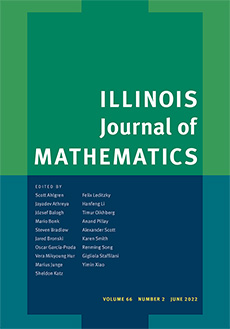Abstract
Given a triangular array with random variables in the th row and a growth rate with , if the empirical distributions converge for any subarrays with the same growth rate, then the triangular array is asymptotically independent. In other words, if the empirical distribution of any random variables in the th row of the triangular array is asymptotically close in probability to the law of a randomly selected random variable among these random variables, then two randomly selected random variables from the th row of the triangular array are asymptotically close to being independent. This provides a converse law of large numbers by deriving asymptotic independence from a sample stability condition. It follows that a triangular array of random variables is asymptotically independent if and only if the empirical distributions converge for any subarrays with a given asymptotic density in . Our proof is based on nonstandard analysis, a general method arisen from mathematical logic, and Loeb measure spaces in particular.
Citation
H. Jerome Keisler. Yeneng Sun. "On the converse law of large numbers." Illinois J. Math. 64 (2) 199 - 225, June 2020. https://doi.org/10.1215/00192082-8303485
Information





